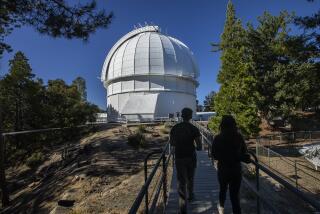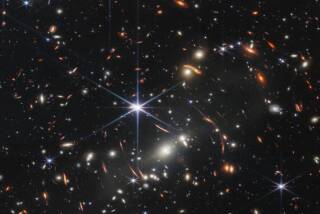Experts Find Prescription for a Blurry-Eyed Hubble : Space: A NASA-commissioned team discovers the root of the telescope’s problems--and it can be fixed.
- Share via
Scientists now so clearly understand the cause of the flawed vision that has crippled the highly touted Hubble Space Telescope that the $1.5-billion instrument can be fully repaired during a shuttle mission in 1993, according to the chief investigator of the mishap.
Until the completion of an investigation led by Jet Propulsion Laboratory Director Lew Allen, scientists feared that they might never understand the problem well enough to build corrective lenses for a replacement wide-field camera that was already scheduled to be installed by a shuttle crew in three years. But now, that concern has been greatly eased.
“There is no doubt now that knowing precisely how the error was made, one can bring the performance of the telescope back to its original specifications,” Allen said in an interview this week.
The committee of experts, established by the National Aeronautics and Space Administration after the discovery that the telescope could not be focused properly, blamed the failure on two monumental errors. The mistakes caused the manufacturer to build a primary mirror for the telescope that “was the most precise mirror ever made, but precisely wrong,” Allen said.
The investigators found that one critical piece of equipment was used upside down, and that a narrow beam of light designed to pass through a pinhole in a lens cap instead reflected off the cap itself.
Those conclusions emerged from evidence that had been gathering dust at a Connecticut industrial complex ever since the mirror was fabricated a decade ago. That evidence, consisting of the tools used to build the mirror, constitutes a “fossil record” of precisely what went wrong, Allen said. Fortunately, he added, the nature of the failure has emerged so clearly that it is now possible to alter a second-generation wide-field camera and restore the Hubble’s vision.
The story could have had a very different ending. Had the record been destroyed, or had the problem consisted of myriad smaller errors instead of a couple of major blunders, scientists might never have been able to come up with the prescription needed to correct Hubble’s blurred vision.
“God didn’t have to smile on us,” Allen said.
The Hubble Space Telescope, billed as the most sophisticated scientific instrument ever built, was launched from the space shuttle Discovery on April 24. The telescope experienced problems almost immediately, as had been expected by engineers who were pioneering a new arena, but NASA publicly expressed confidence that the troubles would soon be solved.
That kind of optimism was still gushing forth when the first images came down, and the space agency proudly released the photographs along with pictures from ground-based telescopes to show how much of an improvement the Hubble represented. But astronomers knew immediately that something was terribly wrong.
Hubble’s vision was flawed, and no amount of reassurance from NASA scientists and engineers eased their concerns.
Many astronomers immediately recognized that the telescope was suffering from something called “spherical aberration,” which means that its 96-inch primary mirror--the larger of its two mirrors--was not focusing the light from distant stars to the precision the Hubble was supposed to achieve. That kind of defect is common because it is extremely difficult to grind a primary mirror in the hyperbolic shape that will focus incoming light at exactly the right point.
A primary mirror must be slightly cupped so that it concentrates the incoming light on a secondary mirror. That means that the grinding wheel must adjust the curvature as it moves from the center, and that is difficult to achieve on the level demanded for the Hubble.
The Hubble was already on orbit when it was discovered that the mirror had been ground to the wrong curvature. A stunned NASA insisted that the problem could be corrected with special lenses added to a replacement camera. But engineers at JPL, charged with correcting the problem, would have to know the exact character of the flaw to prescribe the corrective lenses, and that would be hard to determine since the telescope was in space.
Allen was asked by NASA headquarters to head a team of experts with a singular charge: to find out what had gone wrong.
If the problem were spherical aberration, as nearly all the experts suspected, the primary mirror was more than a millimeter off. That is an astounding error for a mirror that was to have been nearly perfect.
“It seemed unlikely that this had resulted from some combination of small errors,” Allen said. “There almost had to be a blunder somewhere.”
The team looked to a device called a null corrector, a precise instrument designed to create an “optical template,” which provides a pattern for grinding the primary mirror.
But did the null corrector even exist 10 years after the fact? Allen’s team found it in a test facility at the Connecticut firm, formerly known as Perkin Elmer Corp., that ground the mirrors for NASA. The company was acquired a couple of years ago by Hughes Aircraft.
“This equipment had been sitting there with dust on it,” Allen said. “Nobody had been around it (in the years since the mirror was fabricated).”
“We had a fossil record” out of which to reconstruct the events, he said.
And it turned out that the record revealed two errors involving the null corrector.
The corrector must be positioned in exactly the right spot for the mirror to be ground to the right prescription. To do that, the corrector measures distances on the basis of fractions of a wavelength of light, an extremely small distance.
It also uses a steel rod of a specific length to separate two critical components in the system. The top of the rod is positioned at a “point in space” that is established by focusing a beam of light to a pinpoint. If that is done correctly, the bottom of the rod will be at exactly the right place for the placement of a critical lens that will create the optical template, or grinding pattern.
The top of the rod was slightly rounded and was fitted with a cap that had a pinhole through which the narrow beam of light was supposed to pass. The rounding of both the top of the rod, and the cap with its pinhole, were designed to ensure that the pinpoint of light hit the top point of the rod so the rod’s bottom would be at the correct distance for the critical lens.
The investigators found the first “blunder” when they looked at the rod. It had been placed in the cap upside down, with the flat end instead of the rounded end pointing up. That meant the rod was not as high as it should have been because it could not fit snugly against the top of the cap.
The cap itself had been coated with a non-reflective material to keep the beam of light from bouncing off the cap instead of passing through the pinhole.
“But another bad thing had happened,” Allen said. “Somewhere along the line they must have gotten some crud in this pinhole, and they must have cleaned it out with a tool of some kind. So it turned out that there was a little area (around the pinhole) where the non-reflecting material had been worn off.”
When the operator tried to focus the device during the grinding, he got a blurred signal when the beam passed through the pinhole because the inverted rod was farther away than it should have been. But when the beam hit the area near the pinhole that had been robbed of the non-reflective coating, it bounced back with a sharp image.
Thinking that the beam had hit the right spot, the operator adjusted the rod 1.3 millimeters below where it should have been, changing the shape of the mirror. And that is exactly the right amount of error to produce the flaw that was detected in the orbiting telescope.
Allen and his experts had their answer.
“The remaining question was why it wasn’t detected before flight,” said Allen, a former Air Force chief of staff who will retire from JPL in December. “The sad thing,” he added, is that there were a number of opportunities to detect the flaw, and there were some clues that should have made the people at Perkin Elmer aware of the fact that they had a problem.
The rod, for example, is moved up and down by a setscrew. While moving the rod “they ran out of travel on the screw, so they stuck some washers in there,” Allen said. “At first we thought the washers were the cause of the problem. They weren’t, but the washers were an indication. They had designed this thing so carefully, why did they need washers at the last minute?”
Some would argue that the firm, noted for its fine mirrors used in spy satellites, relied too much on the quality of its null corrector. But other tests were not considered adequate for a mirror that had to be nearly perfect, so the company put most of its effort into building a corrector that would be the most precise instrument they could make.
And that, in retrospect, may have been the biggest blunder of all.
The company has not challenged the findings of the Allen committee.
As for the future of the Hubble, the chances are “quite good” that the second-generation wide-field camera, built by Caltech and JPL, will someday see with the clarity that was intended. These latest discoveries of the errors have made that possible, Allen said.
HUBBLE’S FAULTY MIRROR: WHAT HAPPENED
Two monumental errors were committed when a device called a “null corrector” was used during the grinding of the primary mirror for the Hubble Space Telescope. The errors resulted in a mirror that was ground to the wrong shape, thus flawing the Hubble’s vision. 1. A positioning rod used to separate two elements in the null corrector was inverted. A rounded end, which was supposed to slide completely into a top cap, was pointed down instead of up, so the rod did not slide all the way in. 2. A beam of light was supposed to pass through a pinhole in the cap and bounce off the rounded end of the rod, thus telling operators the precise location of the rod. But the light bounced off the cap instead, indicating that the rod was higher than it really was. The two errors resulted in a 1.3-millimeter error, enough to account for the flaw in the mirror.






